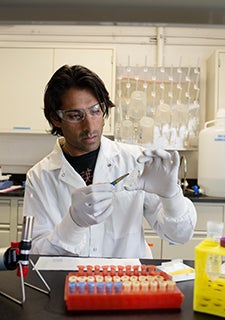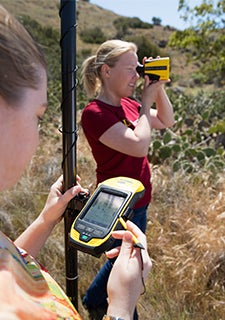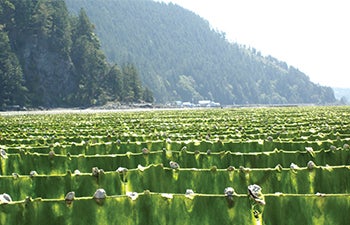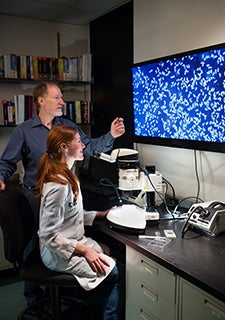Treasure Island
From a helicopter circling above Catalina Island, one might see gorgeous, bathing suit-clad couples sipping mimosas on yachts with names like Been There, Done That.
But when the helicopter swoops past Avalon Bay, beyond the zip liners and golf carters, there, at the island’s isthmus, researchers are making major discoveries.
Perched above a pebbly beach is the 30,000-square-foot Philip K. Wrigley Marine Science Center. The research building contains eight laboratories that accommodate as many as two dozen scientists and 60 students.
Faculty and students take USC’s Miss Christi to the spearmint-blue Big Fisherman’s Cove, near Two Harbors, where they dock and unite in an informal, collaborative setting for research and training. Located 22 miles from Los Angeles, the center is a crown jewel of the USC Wrigley Institute for Environmental Studies, housed at USC Dornsife. The institute’s headquarters is at the University Park campus.
“The cornerstone of the USC Wrigley Institute’s mission is to advance fundamental knowledge of our ocean, our Earth and her systems,” said Roberta Marinelli, the USC Wrigley Institute’s executive director.
The USC Wrigley Institute has the best of both worlds. Most of its laboratories are based in Los Angeles, an expansive, international, coastal city that is environmentally stressed. Situated in a naturally arid region with dense transportation networks and a large population abutting the shoreline, the city offers the perfect setting for the study of sustainable, urban, coastal living.
By contrast, the center on Catalina Island provides a rare setting for researchers to study differences between urban, coastal Los Angeles and less impacted environments. An hour from the sprawl of Los Angeles, the center gives researchers a platform for comparative study of human and natural systems at the land-water interface.
Founded in 1995 by the Wrigley family, the chewing gum dynasty committed to USC and conservation, the institute is devoted to a multidisciplinary approach to improving our understanding of the changing world. Researchers are finding ways to use natural resources more wisely, Marinelli said.
“Our approach is simple,” she said. “We enable rigorous research in the laboratory and in the field; we train students of all ages; and we translate new knowledge into innovative and effective solutions with commercial potential and social impact.”
In addition to laboratories at the University Park campus, much of the research takes place at the center on Catalina and offshore.
One National Science Foundation (NSF)-supported, three-year interdisciplinary project brings together a biologist and linguist to engage in fundamental discovery. Andrew Gracey, associate professor of biological sciences, recalled when Khalil Iskarous, assistant professor of linguistics, invited him to be co-investigator on a project that uses twisting, squirming octopuses and the worm Caenorhabditis elegans to study the human tongue during speech.

Postdoctoral researcher Anand Patel studies ocean sediment.
In an Octopuses’ Garden
“It took a while for me to get my head around the research,” Gracey said. “Khalil explained that the human tongue is almost like an ancestral invertebrate muscle. It’s found in octopuses that have many different limb movements.
“Khalil’s theory is that these limb movements reflect similar movements that the tongue uses within the mouth. Both use very highly controlled hydrostatic muscles. So his idea was that we would compare and contrast the movements of the tongue with those of the octopus and worm to find general principles about how this type of muscle is controlled.”
Octopuses are kept in tanks at the center. Researchers videotape them while they contort their limbs in various ways — to pivot, walk and run. They compare these movements to ultrasound images of human tongues in motion.
Gaining a deeper understanding of the principles of animal movement can give scientists a better handle on the effect on speech due to Parkinson’s and other diseases.
“So you have biologists working on octopus limb movements and you have linguists working on tongue movement,” said Gracey, noting that his and Iskarous’ students are involved in the research. “I don’t think anyone has ever before tried to bridge the two genres.”
That kind of collaboration is why the center is an open campus without departments, Marinelli said.
“Human health and environmental problems are broader than any one discipline and require integrative thinking,” she said, noting that the Wrigley Institute works on basic research and environmental science that are locally and globally relevant.
For example, science tells us that ocean microbes provide half the oxygen we breathe. The institute’s research is also showing how carbon dioxide affects our ocean’s chemistry and biology and what this means for the Earth’s future. Its scientists are advancing the understanding of the effects of urban runoff and factors causing harmful algal blooms.
“Atmospheric carbon dioxide is the ultimate transboundary problem,” Marinelli said. “The atmosphere is global; it touches the surface ocean and land everywhere. It has the prospect of altering the oceans biogeochemical cycles, gas exchange and heat flow. The climate change issue raises huge questions about responsibility on a very broad scale.”
Climate change is a topic often discussed at the George and MaryLou Boone Center for Science and Environmental Leadership — a think-tank and forum located near the laboratories on Catalina.
In addition to USC Dornsife professors, academics from around the world gather at the Boone Center to debate and design solutions to enormous issues.
Another biggie is world hunger.
Focusing on that issue are geneticist Dennis Hedgecock, Paxson H. Offield Professor in Fisheries Ecology and professor of biological sciences, and environmental physiologist Donal Manahan, professor of biological sciences.
Maize of the Sea
Outside the center on Catalina is Hedgecock and Manahan‘s open-air oyster hatchery. The professors are hoping to increase food from the ocean by advancing the concept of “hybrid vigor” in which animals are crossed to produce “gangbuster growers” resistant to various environmental stressors.
They received a four-year NSF grant to predict the winners and losers in ocean acidification, a term used for the ongoing decrease of pH in the Earth’s oceans caused by carbon dioxide absorption from the atmosphere. Even within species, biological responses to ocean acidification vary.
A fuller understanding of how marine animals function during environmental change requires a merging of physiological, genetic and environmental research, Manahan and Hedgecock said. They are researching Pacific oysters, which have genetic and genomic resources unparalleled for most marine animals.
“Hybrid vigor is an example of trying to improve the growth rate of animals in the face of ocean acidification,” Hedgecock said. “This is an aspect of the sustainability issue.”
The pair is bringing in undergraduate, graduate and postdoctoral researchers to assist in the study, said Manahan, USC Dornsife’s vice dean for students. The two have worked closely with the West Coast oyster industry for more than a decade. They expect their research to translate directly into improved breeding programs for the West Coast oyster industry, valued at more than $100 million annually.
Moreover, findings may be applicable to other highly fecund marine species, such as fish and other commercially important species that provide a major source of food for human consumption. An estimated nine billion people will occupy the Earth by 2050, according to United Nations experts.
“We have states overheating, shortages of water on land and ocean acidification,” Manahan said. “We’re making marine ‘seeds’ — larvae, early stages of animal development — that can handle those kinds of environmental stressors. This is urgent for society. Unless we improve food production, we may have less food on the dinner table.”

Graduate students Elizabeth Hart (left) and Jessica Eselius use a Trimble GeoXH to collect data.
Truth and (Climate Change) Consequences
The monumental climate change issue is another institute priority. In 2010, USC Dornsife funded a collaborative project titled “Climate Change in the Southern California Bight,” directed by David Hutchins, professor of biological sciences, and Douglas Capone, holder of the William and Julie Wrigley Chair in Environmental Studies and professor and chair of the Department of Biological Sciences.
A main goal of the project is to increase communication and promote dialogue among the diverse people who deal with all aspects of ocean climate change in the Los Angeles area, the Southern California region and the world.
Hutchins and Capone held regional conferences and workshops bringing together fishery representatives, scientists, policymakers and the public to better understand the interplay among climate change, ocean health and human impacts.
The Southern California Bight — the ocean area stretching south from Point Conception in the north down to Ensenada in Mexico — is a model system. It is one of the most carefully monitored coastal regions in the world and its surrounding universities and governmental agencies provide tremendous scientific expertise.
“So it behooves us to marshal those forces,” Capone said.
As the water becomes warmer and more acidic, the microbial communities that create the foundation of marine ecosystems may reconfigure, Capone said.
USC Dornsife scientists are at the forefront of the efforts to predict the future for marine microbes. In a new field requiring new scientific models, they combine marine and evolutionary biology to study global climate change.
In a study published in September 2013 in Nature Geoscience, Hutchins examined which organisms will thrive and which will perish with the altering ocean. Changes in nitrogen-fixing cyanobacteria — bacteria that obtain energy through photosynthesis — have implications for every living thing in the ocean, because all forms of life require nitrogen fixers to survive.
In the same issue, Capone and Hutchins reviewed the array of chemical and physical parameters being modified in coastal upwelling systems as a result of human influences including climate change, and the implications of such changes for these highly productive marine ecosystems.
“Our findings show that CO2 has the potential to control the biodiversity of these keystone organisms in ocean biology, and our fossil fuel emissions are probably responsible for changing the types of nitrogen fixers that are growing in the ocean,” Hutchins said.
David Caron, professor of biological sciences, and Hutchins recently published an article in the Journal of Plankton Research discussing these new lines of research. They are investigators for an ongoing NSF grant that led to the recent publication of three papers by Avery Tatters, a Ph.D. student in Hutchins’ lab.
Caron, Hutchins, Tatters and other USC Dornsife researchers are conducting first-of-their-kind, long-term experiments on the reaction of microbes to increasing levels of carbon dioxide — which lower the pH of water making it acidic — in seawater.
With Hutchins as the principal investigator, researchers have obtained a four-year NSF grant to continue studying how nitrogen-fixing cyanobacteria may evolve in response to variables that include increasing carbon dioxide and temperatures.
Researchers, including Tatters and graduate student Yungsheng Luo, conduct these experiments in labs on Catalina and the University Park campus. They are also studying the triggers of potentially deadly algal blooms, known as red tides.
“These huge, toxic blooms that are already causing big problems in our area may get worse in the future as the pH of the ocean decreases,” Hutchins said.

Seeking to produce gangbuster growers, USC Dornsife faculty members are cross breeding Pacific oysters.
Blooming Awful
In 2005, King Harbor in Redondo Beach, Calif., experienced a massive fish kill. Millions of dead fish later clogged the harbor.
Some worried that the episode was due to red tides, which occur after the rapid reproduction of microscopic plankton. This eventually releases powerful neurotoxins that can damage the brains of shellfish and marine mammals such as sea lions and pelicans — and humans who may eat the seafood.
“It actually fires the nerves and will literally burn out synapse connections in the brain, which causes various symptoms ranging from nausea all the way to convulsions and death if you take enough of it in,” Caron said.
Caron is working with a team that has launched two missile-shaped, robotic gliders into the sea — one between the USC Wrigley Marine Science Center on Catalina Island and Point Fermin and another off the coast of Huntington Beach. As the gliders scour the ocean, they gather vital information Caron uses to detect potentially dangerous developments in the ocean that could lead to a major loss of marine life.
The glider project is funded by the National Oceanic and Atmospheric Administration, National Science Foundation, U.S. Environmental Protection Agency, NASA and the Office of Naval Research. Each glider costs about $120,000.
More recently, in 2011, a few million silvery sardines went belly up at King Harbor. Caron was among the first at the scene. He and his researchers checked their sensor equipment suspended in the harbor since the 2005 fish kill. Their sensors record the measurements of temperature, salinity, chlorophyll and plant pigment in the water every half hour, detecting any possible algal blooms and toxic algae.
The instruments suspended in the harbor throughout the event revealed that the fish were killed by a lack of oxygen in the harbor water. There was no algal bloom or toxic algae present.
Caron conducts this research as part of a five-year National Oceanic and Atmospheric Administration grant to investigate early detection of harmful algal blooms in coastal California.
The causes of red tide are hotly debated among scientists, with nutrient inputs from agricultural run-off and sewage, and climate change as possible culprits.
“In the case with King Harbor in 2011, too many fish entered the marina, and there wasn’t enough oxygen for them to survive,” Caron said. “Gliders help us wire the ocean, and with this constant surveillance, we are on the verge of being able to predict and mitigate these events.”
The Redondo Beach City Council has honored Caron and his researchers for their efforts concerning the fish kills. Caron is also working with the Orange County Sanitation District (OCSD) and the Hyperion Treatment Plant in Los Angeles to examine the effect of effluent discharging from pipes in deep water five miles offshore.
“They discharge secondarily treated sewage, and that effluent contains tons, literally tons of nutrients,” Caron said. “We’ve been looking at what the potential impact of that discharge might be to local phytoplankton communities.”
Most of the nutrients boil down to ammonia and phosphate. If they are discharged deep into the water column below the light zone where algae photosynthesize, there is less concern. However, in Fall 2012, the OCSD had a “diversion event” in which it had to use an older, shorter pipe while the longer pipe was being repaired.
“The shorter pipe is only a mile long and discharges in shallow water,” Caron said. “So, the potential is that the shorter pipe introduces nutrients directly into the lighted surface waters, and they could cause massive phytoplankton blooms.”
Caron and his team worked closely with Orange County to ensure proper planning and monitoring and will do the same with the Hyperion Treatment Plant when it goes through a similar diversion event in 2014.
“We’ve worked with Orange County Sanitation District and Hyperion for years now,” Caron said. “We’ve developed a trust and a relationship. They could try and brush everything under the rug, but they don’t. They know that we will do a good, honest and objective job of looking at the effects of events like diversions.
“They’re very eager to make sure they have informed and impartial people participating.”
Marinelli said improving the community’s environmental health and tapping into L.A.’s resources are part of the institute’s beauty.
“It’s not just about scientific findings, it’s about translating the science for public benefit,” she said. “It’s about talking to other disciplines that are going to help us understand how we can communicate with people to let them know that, for example, the choice of their next vehicle should include more than just the cost of the car. They should think about the environmental implications.
“Decisions should have some aspect of environmental responsibility embedded in them,” she said.
Among the institute’s newest, most cutting-edge disciplines, Marinelli named spatial sciences. Looking through a spatial lens takes geography to a whole new level.

Professor David Caron and postdoctoral researcher Victoria Campbell view algae cultures. Caron studies the causes of potentially deadly algal blooms in coastal California.
A Space in Time
“We live in an evermore crowded and connected world,” said John Wilson, professor of sociology, civil and environmental engineering, computer science and architecture, and director of USC Dornsife’s Spatial Sciences Institute. “Our success in its various guises — the arts, economics, human health, politics, sustainability — depends on our ability to understand and anticipate the opportunities and constraints afforded by specific places and the connections between them.
“Fortunately,” he said, “we live in an era when we have unprecedented technologies to help us with these tasks.”
Fundamental geoprocessing tools — Geographic Information Systems, Global Positioning Systems, remote sensing, and Location-Based Services — have evolved tremendously in the past three decades.
“We now live in a world where, to some, geographic information is among a small set of core infrastructures,” Wilson said. “It increasingly permeates our everyday lives, but the adoption and effective use of spatial thinking and methods in our instructional and research programs lag far behind. We aim to change this.”
Graduate students in the institute’s online Geographic Information Science and Technology (GIST) program are using the tools in unique research projects. One is Matthew Bissell.
Bissell took notice when a female blue whale and fetus were found washed ashore in Pescadero, Calif., putting the U.S. Coast Guard on high alert. The protected mammal that can span 100 feet and weigh 150 tons had been plowed over by a cargo ship.
The mangled carcasses of four more whales struck and killed by ships were found along the West Coast during the summer of 2010. But officials suspect many more — lured by an abundance of krill into the paths of ships — faced the same fate. They’ll never get an accurate count as dead whales tend to sink.
A deckhand on whale-watching excursions for the Ocean Institute in Dana Point, Calif., Bissell has an affinity for these majestic creatures, especially blue whales — the largest animal ever to exist on Earth.
“Blue whales are huge and incredibly powerful,” said Bissell, who recently earned his master’s degree in GIST through the institute.
“Seeing one come to the water’s surface and hearing it breathe is an incredible experience,” said Bissell, whose adviser was Travis Longcore, associate professor of spatial sciences research. “The sound is like water rushing through a cave. I’ve seen children so in awe they cry.”
This is where Bissell’s citizen science comes in. In an effort to curtail collisions, he hopped aboard whale watching ships from San Diego to San Pedro. Transcribing captains’ logbooks, he gathered an extensive dataset of observations for blue, fin and minke whales. Quarterly scientific transcripts found 64 blue whales over eight years. By comparison, Bissell’s dataset includes 2,300 blue whale sightings in half that time.
Bissell developed a habitat suitability model for blue whales, finding that their distribution on a monthly basis was influenced mostly by bathymetry — or underwather depth — followed by sea surface temperature and chlorophyll. The habitat model was then compared to shipping activity.
The study is positioned to influence policy to reduce ship collisions with protected species. It is also meant to help companies decide when and where to bring tourists to see whales swimming in their natural habitat.
Another application of geospatial technologies was recently conducted by a graduate student team surveying wheelchair accessibility at Two Harbors, Catalina.
“It was an attempt to build a spatial analysis map that describes the little town of Two Harbors from the perspective of somebody in a wheelchair,” said Darren Ruddell,
a senior lecturer of spatial sciences who primarily teaches in GIST programs. “The students had to know all of the roads, how wide they were, characterize what kinds of surface they have and note all walls.
“They had to go literally everywhere. They went to a little bluff at the coast and worked their way back up toward the road that goes to Two Harbors. They went through brush; they were pretty beat up by the end of three days.”
Undergraduates also benefit from GIST. NSF’s Research Experience for Undergraduate programs draws students nationwide. In collaboration with the USC Wrigley Institute, Ruddell and his colleagues mentored two students during this past summer.
Tara Kelly and Clifford Hoang created a 3-D rendering of Big Fisherman’s Cove at Catalina. They measured nutrient load, acidity, salinity, pH and temperature with an eye to detect possible polluted areas in the protected waters. Kelly, a senior at Villanova University in Villanova, Penn., said she wants to pursue a field combining GIST with research that can benefit Mother Nature.
“Once I looked at the USC Wrigley Institute Web site and saw their center on Catalina, I thought, ‘This looks really interesting,’ ” Kelly said. “It’s merging technology with island life.”
Another GIST team examined hiking trails on Catalina.
“Many people go to Catalina for recreation,” Ruddell said. “They want to know where the trails are. What kind of condition the trails are in. Are they strenuous, are they easy? What are the distances? What are the elevation profiles? So these students mapped trails, performed statistical analyses and are now developing an app. So visitors will have access to all hiking trails.”
At Wrigley, researchers don’t follow where those paths lead. As Ralph Waldo Emerson would say, they go instead where there is no path and leave a trail.
Read about the USC Dornsife Sustainability Task Force
Read more stories from USC Dornsife Magazine‘s Fall 2013-Winter 2014 issue